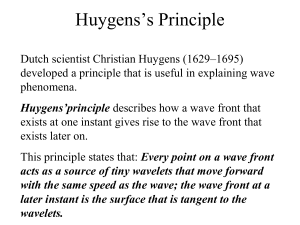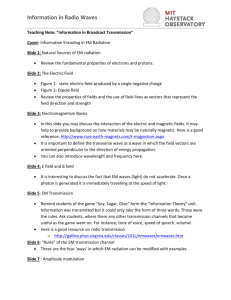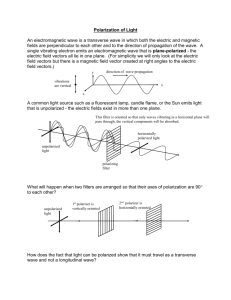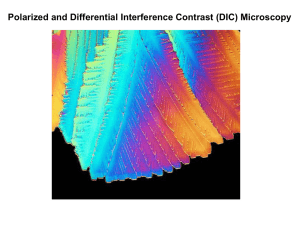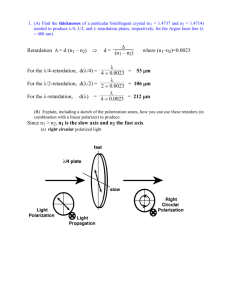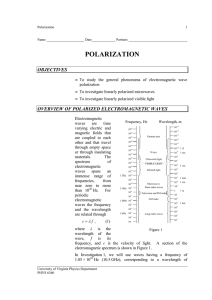1 From http://micro.magnet.fsu.edu/optics/lightandcolor/polarization
advertisement
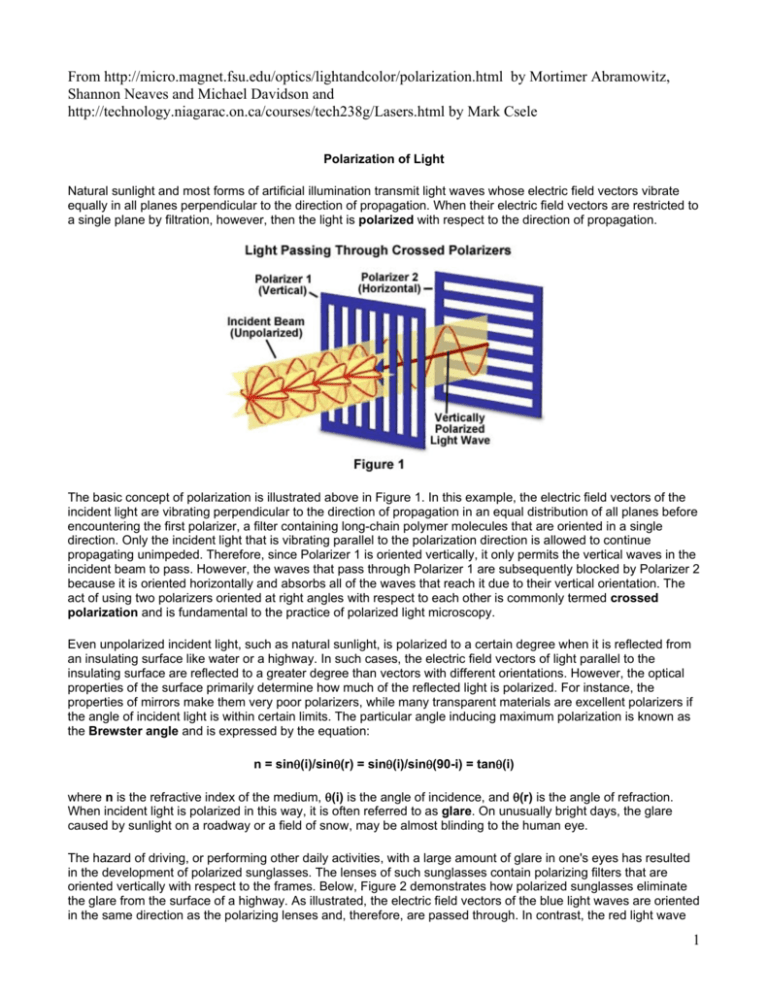
From http://micro.magnet.fsu.edu/optics/lightandcolor/polarization.html by Mortimer Abramowitz, Shannon Neaves and Michael Davidson and http://technology.niagarac.on.ca/courses/tech238g/Lasers.html by Mark Csele Polarization of Light Natural sunlight and most forms of artificial illumination transmit light waves whose electric field vectors vibrate equally in all planes perpendicular to the direction of propagation. When their electric field vectors are restricted to a single plane by filtration, however, then the light is polarized with respect to the direction of propagation. The basic concept of polarization is illustrated above in Figure 1. In this example, the electric field vectors of the incident light are vibrating perpendicular to the direction of propagation in an equal distribution of all planes before encountering the first polarizer, a filter containing long-chain polymer molecules that are oriented in a single direction. Only the incident light that is vibrating parallel to the polarization direction is allowed to continue propagating unimpeded. Therefore, since Polarizer 1 is oriented vertically, it only permits the vertical waves in the incident beam to pass. However, the waves that pass through Polarizer 1 are subsequently blocked by Polarizer 2 because it is oriented horizontally and absorbs all of the waves that reach it due to their vertical orientation. The act of using two polarizers oriented at right angles with respect to each other is commonly termed crossed polarization and is fundamental to the practice of polarized light microscopy. Even unpolarized incident light, such as natural sunlight, is polarized to a certain degree when it is reflected from an insulating surface like water or a highway. In such cases, the electric field vectors of light parallel to the insulating surface are reflected to a greater degree than vectors with different orientations. However, the optical properties of the surface primarily determine how much of the reflected light is polarized. For instance, the properties of mirrors make them very poor polarizers, while many transparent materials are excellent polarizers if the angle of incident light is within certain limits. The particular angle inducing maximum polarization is known as the Brewster angle and is expressed by the equation: n = sinθ(i)/sinθ(r) = sinθ(i)/sinθ(90-i) = tanθ(i) where n is the refractive index of the medium, θ(i) is the angle of incidence, and θ(r) is the angle of refraction. When incident light is polarized in this way, it is often referred to as glare. On unusually bright days, the glare caused by sunlight on a roadway or a field of snow, may be almost blinding to the human eye. The hazard of driving, or performing other daily activities, with a large amount of glare in one's eyes has resulted in the development of polarized sunglasses. The lenses of such sunglasses contain polarizing filters that are oriented vertically with respect to the frames. Below, Figure 2 demonstrates how polarized sunglasses eliminate the glare from the surface of a highway. As illustrated, the electric field vectors of the blue light waves are oriented in the same direction as the polarizing lenses and, therefore, are passed through. In contrast, the red light wave 1 represents glare, which is parallel to the surface of the highway. Since the red wave is perpendicular to the filters in the lenses, it is successfully blocked by the lenses. Another interesting use of light polarization is the liquid crystal display (LCD) utilized in applications such as wristwatches, computer screens, timers, and clocks. These devices are based upon the interaction of rod-like liquid crystalline molecules with an electric field and polarized light waves. The liquid crystalline phase exists in a ground state that is termed cholesteric, in which the molecules are oriented in layers and each successive layer is slightly twisted, forming a spiral pattern. When a polarized light wave interacts with the liquid crystalline phase, the wave is twisted by an angle of approximately 90 degrees with respect to the incident wave. This angle is a function of the helical pitch of the cholesteric liquid crystalline phase, which is dependent upon the chemical composition of the molecules. However, the helical pitch may be fine-tuned if small changes are made to the molecules. A prime example of the basic application of liquid crystals in display devices is the seven-segment LCD numerical display illustrated in Figure 3. Here, the liquid crystalline phase is sandwiched between two glass plates that have seven electrodes, which can be individually charged, attached to them. Although the electrodes appear black in this example, they are transparent to light in real devices. As demonstrated in Figure 3, light passing through Polarizer 1 is polarized in the vertical direction and, when no current is applied to the electrodes, the liquid crystalline phase induces a 90 degree twist of the light and it can pass through Polarizer 2, which is polarized horizontally. This light can then form one of the seven segments on the display. 2 When current is applied to the electrodes, however, the liquid crystalline phase aligns with the current and loses the cholesteric spiral pattern. Therefore, light passing through a charged electrode is not twisted and is blocked by Polarizer 2. By coordinating the voltage on the seven positive and negative electrodes, the display is capable of rendering the numbers 0 through 9. In this example, the upper right and lower left electrodes are charged and, consequently, block light from passing through them, which results in the formation of the number "2". Polarization of light is also very useful in many aspects of optical microscopy. Microscopes may be configured to use crossed polarizers, in which case the first polarizer, described as the polarizer, is placed below the sample in the light path and the second polarizer, known as the analyzer, is placed above the sample, between the objective and the eyepieces. If the microscope stage is left empty, the analyzer blocks the light polarized by the polarizer and no light is visible. However, when a birefringent, or doubly refracting, sample is placed on the stage between the crossed polarizers, the microscopist can visualize various aspects of the sample. This is because the birefringent sample rotates the light, allowing it to successfully pass through the analyzer. How Lasers Work Laser light has several features that are significantly different from white light. To begin with, light from most sources spreads out as it travels, so that much less light hits a given area as the distance from the light source increases. Laser light travels as a parallel beam and spreads very little. Furthermore, laser light is monochromatic and coherent. White light is a jumble of colored light waves. Each color has a different wavelength. If all the wavelengths but one are filtered out, the remaining light is monochromatic. If these waves are all parallel to one another, they are also coherent: the waves travel in a definite phase relationship with one another. In the case of laser light, the wave crests coincide and the troughs coincide. The waves all reinforce one another. It is the monochromaticity and coherency of laser light that makes it ideal for recording data on optical media such as a CD as well as use as a light source for long haul fiber-optic communications. 3 The laser uses a process called stimulated emission to amplify light waves. (One method of amplification of an electromagnetic beam is to produce additional waves that travel in step with that beam.) A substance normally gives off light by spontaneous emission. One of the electrons of an atom absorbs energy. While it possesses this energy, the atom is in an excited state. If the electron gives off this excess energy (in the form of electromagnetic radiation such as light) with no outside impetus, spontaneous emission has occurred. If a wave emitted by one excited atom strikes another, it stimulates the second atom to emit energy in the form of a second wave that travels parallel to and in step with the first wave. This stimulated emission results in amplification of the first wave. If the two waves strike other excited atoms, a large coherent beam builds up. But if they strike unexcited atoms, they are simply absorbed, and the amplification is then lost. In the case of normal matter on Earth, the great majority of atoms are not excited. As more than the usual number of atoms become excited, the probability increases that stimulated emission rather than absorption will take place. 4 Physicist Gordon Gould invented the laser in 1958. The first working model was built in 1960 by T.H. Maiman. It contained a synthetic, cylindrical ruby with a completely reflecting silver layer on one end and a partially reflecting silver layer on the other. Ruby is composed of aluminum oxide with chromium impurities. The chromium atoms absorb blue light and become excited; they then drop first to a metastable level and finally to the ground (unexcited) state, giving off red light. Light from a flash lamp enters the ruby and excites most of the chromium atoms, many of which fall quickly to the metastable level. Some atoms then emit red light and return to the ground state. The light waves strike other excited chromium atoms, stimulating them to emit more red light. The beam bounces back and forth between the silvered ends until it gains enough energy to burst through the partially silvered end as laser light. When most of the chromium atoms are back in the ground state, they absorb light, and the lasing action stops. In continuous-wave lasers, such as the helium-neon laser, electrons emit light by jumping to a lower excited state, forming a new atomic population that does not absorb laser light, rather than to the ground state. 5

